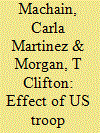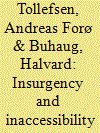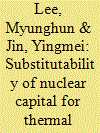|
|
|
Sort Order |
|
|
|
Items / Page
|
|
|
|
|
|
|
| Srl | Item |
| 1 |
ID:
117623


|
|
|
|
|
| Publication |
2013.
|
| Summary/Abstract |
Major powers often deploy troops abroad with the consent of host states. The stated aim of these deployments is often both to protect the host state and to foster stability in the region. Drawing from an extension of Palmer and Morgan's two-good theory of foreign policy, the authors explore some of the (perhaps unintended) effects of troop deployments abroad on the foreign policies of the host states. In particular, the authors focus on the effects of US deployments. The authors argue that as the number of US troops deployed to a host state increases, we should expect the host state to reduce its own troop levels, be more likely to initiate militarized interstate disputes, and be less likely to be the target of interstate disputes. The authors test these hypotheses using data on US troop deployments abroad from 1950 to 2005 and discuss implications that their findings may have for US foreign policy.
|
|
|
|
|
|
|
|
|
|
|
|
|
|
|
|
| 2 |
ID:
140279


|
|
|
|
|
| Summary/Abstract |
Status and the relative ranking of states in international politics seem to be salient concerns for most foreign policymakers. Yet, the literature on how status rankings are attributed to states remains as scarce as research on the strategies utilized by states to maintain or enhance the status they are attributed. While there is more research conducted on both status attribution and status competition regarding major powers and rising powers, little systematic attention has focused on the larger population of states in international politics.
|
|
|
|
|
|
|
|
|
|
|
|
|
|
|
|
| 3 |
ID:
137750


|
|
|
|
|
| Summary/Abstract |
A widely held belief within policy and practice contends that rough terrain and other physical obstacles to power projection hinder public surveillance, lower counterinsurgency capability, and generally constitute an important facilitator of rebellion. Likewise, sociocultural exclusion and alienation from the core are widely assumed to increase latent conflict risk through their influence on identity formation and perception of collective grievances. However, there is no scientific consensus on the empirical strength or significance of such a relationship, and many quantitative studies fail to find a robust link between a country's geographical or ethno-demographic characteristics and its estimated conflict risk. This paper represents a first comprehensive evaluation of how physical and sociocultural inaccessibility relate to contemporary civil wars. Drawing on recent advances in geographic information systems and georeferenced indicators of terrain, settlement patterns, ethno-political status, and armed conflict, we put the purported causal relationship to empirical test. A statistical analysis of civil-conflict events across post-Cold War Africa gives considerable support to the proposed theoretical framework, revealing that the various dimensions of inaccessibility all exert significant and substantive effects on local conflict risk. We find weaker evidence for the notion of substitutability; the inaccessibility indicators largely retain their individual effects when included in the same regression model.
|
|
|
|
|
|
|
|
|
|
|
|
|
|
|
|
| 4 |
ID:
117001


|
|
|
|
|
| Publication |
2012.
|
| Summary/Abstract |
As part of ongoing efforts to reduce CO2 emissions by increasing the proportion of the energy mix relying on nuclear power, it may be useful to substitute nuclear power for thermal power wherever possible, thereby substantially reducing the need to use fossil fuels. In order to evaluate the contribution of nuclear power to potential CO2 reduction, this study examines the substitutability of thermal capital and nuclear capital in the Korean electric power industry by utilizing the input distance function. Additionally, the unit costs of thermal capital and nuclear capital are compared in terms of their shadow prices, which are defined as the opportunity costs inherent to one additional unit of capital increase deriving from a reduction in labor. The empirical results presented herein indicate that nuclear capital is readily substituted for thermal capital, but the substitutability of thermal capital for nuclear capital is relatively low. The shadow price ratio of nuclear capital to thermal capital is estimated to be 15.9, on average, showing an upward trend over the years from 1982 to 2010.
|
|
|
|
|
|
|
|
|
|
|
|
|
|
|
|
| 5 |
ID:
147334


|
|
|
|
|
| Summary/Abstract |
The article analyses the behaviour of net total capital inflow and its components since the introduction of liberalisation in India in 1991. An introspective analysis of capital flow reveals that capital inflow in India is volatile in nature and it is volatile in exactly the wrong direction, in a sense that it is pro-cyclical rather than countercyclical. However, all types of flows should not be treated equally. Being the most volatile and least persistent components, FPI and commercial bank inflow should be monitored very cautiously. The volatility of foreign direct investment (FDI) and commercial borrowing has gradually increased, although it has declined recently. External assistance has declined steadily and lost its dominance relative to the other counterparts. There is ample evidence of complementarity among the components of capital flows though we get a glimpse of substitutability between FDI and FPI—the two most voluminous components of capital flows. Contrary to a-cyclical, non-debt creating flows, commercial borrowings and commercial bank flows are found to be pro-cyclical in nature. The net total capital inflow series contain three structural breakpoints, at 1995Q4, 2002Q4 and 2006Q2. Domestic growth performance, policy changes and external shocks are the key factors behind these obtained structural breaks. There was a noticeable change in the behaviour of total capital flow and its components over the four phases identified in the article.
|
|
|
|
|
|
|
|
|
|
|
|
|
|
|
|
|
|
|
|
|